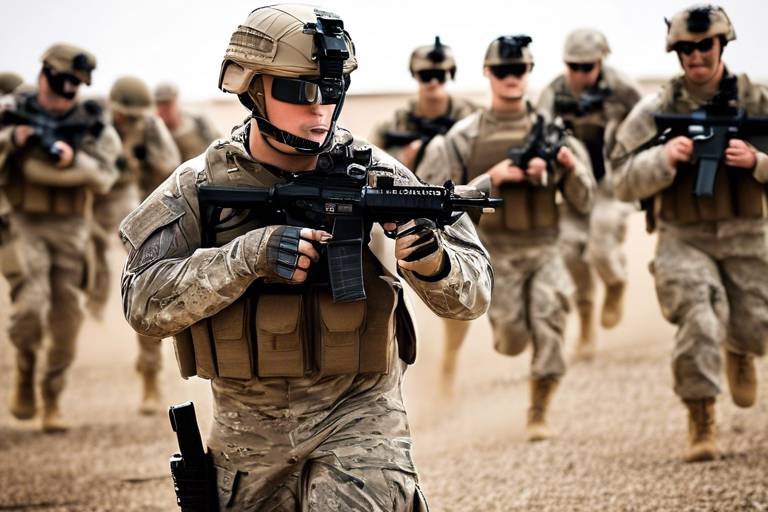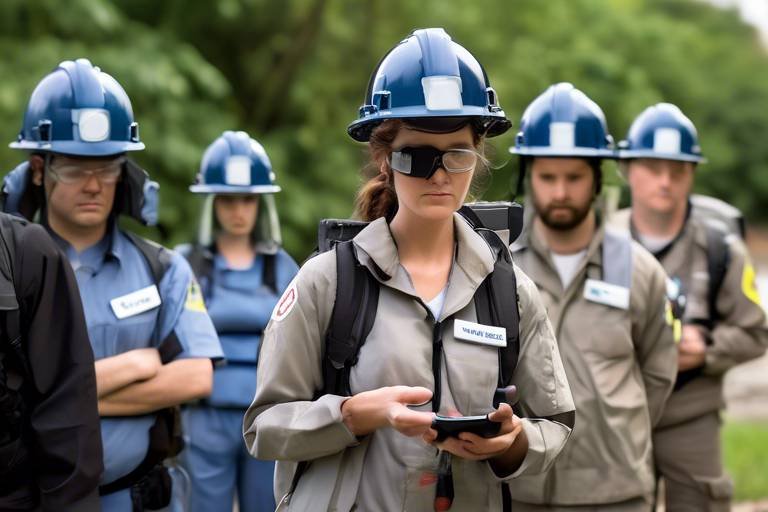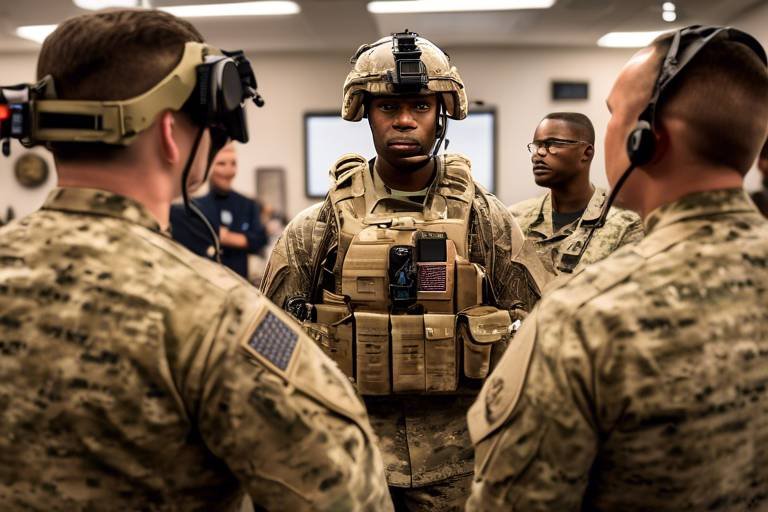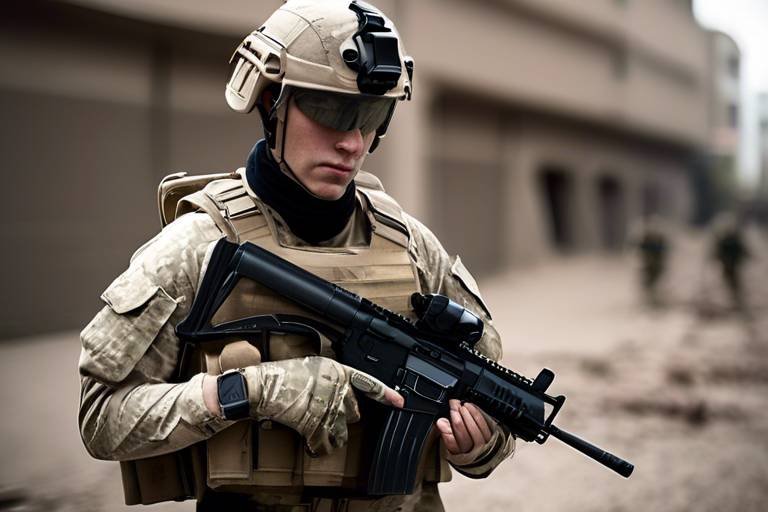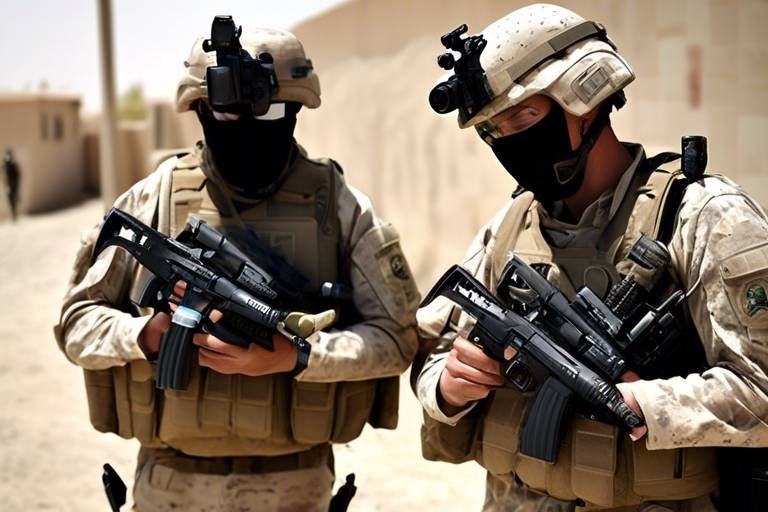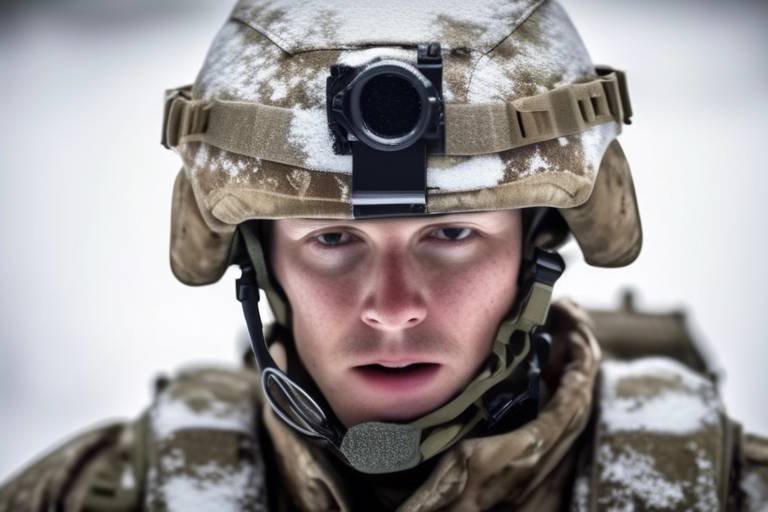How Smart Wearables Are Shaping Military Training Protocols
In the ever-evolving landscape of military training, smart wearables are emerging as game-changers, drastically enhancing the way soldiers prepare for their missions. Imagine a world where every move a soldier makes is tracked, analyzed, and optimized in real-time. This isn't science fiction; it's happening now. Smart wearables, ranging from fitness trackers to augmented reality goggles, are being integrated into training protocols, creating an environment where data-driven decisions lead to superior performance and safety.
The impact of these devices is profound. They provide real-time data and analytics that help trainers fine-tune exercises and improve soldiers' readiness for various operational scenarios. Think of it as having a personal coach who not only watches your every move but also provides instant feedback and motivation. This is crucial in military training, where the stakes are incredibly high and every second counts. With smart wearables, soldiers can monitor their physical health and performance metrics, ensuring they are always at their best.
Moreover, these devices foster a culture of accountability and teamwork among soldiers. By sharing data, teams can work together more effectively, understanding each other's strengths and weaknesses. This camaraderie is essential in high-stress situations where communication can mean the difference between success and failure. The integration of smart wearables is not just about technology; it's about building a more cohesive and resilient military force.
As we delve deeper into the various types of smart wearables used in military training, we uncover how each device contributes uniquely to enhancing performance and safety. From monitoring health metrics to simulating complex combat scenarios, these technologies are paving the way for a new era of military readiness.
Smart wearables are revolutionizing military training by providing real-time data and analytics, which help improve soldiers' performance and readiness for various operational scenarios. In essence, they act as an extension of the soldier's own capabilities, offering insights that were previously unimaginable. With the help of these devices, trainers can tailor training programs to meet the specific needs of each soldier, addressing individual weaknesses and enhancing strengths.
Imagine a training exercise where each soldier wears a device that tracks their heart rate, oxygen levels, and even stress indicators. Trainers can analyze this data to determine not only how well soldiers are performing but also when they might be at risk of injury or fatigue. This level of insight allows for a proactive approach to training, where adjustments can be made on-the-fly, ensuring that soldiers are always operating at their peak.
Moreover, the integration of smart wearables into military training protocols is not just about performance enhancement; it's also about safety. By closely monitoring health metrics, military trainers can proactively address potential injuries, ensuring soldiers maintain peak performance while minimizing the risk of long-term damage. This focus on health and safety is crucial, as it directly impacts the overall effectiveness of military operations.
Various types of smart wearables, including fitness trackers, smart helmets, and augmented reality goggles, are being integrated into military training programs to enhance situational awareness and physical performance. Each of these devices serves a unique purpose, contributing to a comprehensive training strategy that prepares soldiers for the challenges they will face in the field.
Fitness trackers play a crucial role in monitoring soldiers' physical health, helping trainers assess endurance levels, recovery times, and overall fitness during training exercises. These devices not only track basic metrics like steps and calories burned but also provide deeper insights into heart rate variability and sleep patterns, which are essential for understanding a soldier's readiness.
The data collected from fitness trackers can be analyzed to identify trends and make informed decisions about training regimens, ultimately improving soldier readiness and resilience. For instance, if a soldier consistently shows signs of fatigue, trainers can adjust their training load to prevent burnout and enhance recovery.
By closely monitoring health metrics, military trainers can proactively address potential injuries, ensuring soldiers maintain peak performance while minimizing the risk of long-term damage. This proactive approach is akin to having a safety net in place, allowing soldiers to focus on their training without the constant fear of injury.
Augmented reality devices are enhancing training simulations, allowing soldiers to practice complex scenarios in a controlled environment, improving decision-making and tactical skills under pressure. These devices create immersive experiences that mimic real-life situations, enabling soldiers to hone their skills without the associated risks of live training exercises.
Smart wearables offer numerous benefits, including improved physical fitness, enhanced situational awareness, and better communication, all contributing to a more effective and prepared military force. The advantages extend beyond individual performance, fostering a culture of teamwork and collaboration that is vital in military operations.
Wearables facilitate seamless communication among soldiers during training exercises, ensuring better coordination and teamwork, which are critical in high-stress combat situations. Imagine a scenario where soldiers can instantly share vital information about their surroundings with their team, enhancing situational awareness and enabling quicker decision-making.
With real-time feedback from wearables, soldiers can make immediate adjustments to their training techniques, leading to faster skill acquisition and improved overall performance in the field. This instant feedback loop creates a dynamic training environment where soldiers can continuously learn and adapt, much like athletes refining their skills for peak performance.
- What are smart wearables? Smart wearables are devices that can be worn on the body to monitor and collect data about various physical and performance metrics.
- How do smart wearables benefit military training? They provide real-time data, enhance communication, and improve performance, ultimately leading to better preparedness for soldiers.
- Can smart wearables help prevent injuries? Yes, by monitoring health metrics, trainers can identify potential risks and adjust training to prevent injuries.
- What types of smart wearables are used in military training? Common types include fitness trackers, smart helmets, and augmented reality goggles.
The Role of Smart Wearables in Military Training
Smart wearables are not just a trend; they are revolutionizing military training in ways that were previously unimaginable. Imagine a soldier on the battlefield, equipped with a device that not only tracks their physical condition but also provides real-time analytics on their performance. This is the power of smart wearables. By providing real-time data and analytics, these devices help improve soldiers' performance and readiness for various operational scenarios. They act as an extension of the soldier, offering insights that can be the difference between success and failure in high-stakes situations.
One of the most significant benefits of smart wearables is their ability to gather and analyze data continuously. Soldiers can wear fitness trackers that monitor heart rates, oxygen levels, and even stress indicators. This data is invaluable for trainers who need to tailor training regimens to individual soldiers’ needs. With this information, trainers can identify when a soldier is pushing too hard, allowing them to adjust the training intensity accordingly. It’s like having a personal coach in your pocket, always ready to provide feedback and support.
Moreover, smart wearables enhance situational awareness. In the heat of training exercises, being aware of one’s surroundings can be crucial. Wearables can integrate GPS and mapping technologies, providing soldiers with crucial information about their location and the environment around them. This integration not only helps in training but also prepares soldiers for real-life scenarios where awareness can save lives. Imagine a soldier in a dense forest, relying on augmented reality goggles to navigate through the terrain while receiving updates about potential threats. This kind of technology is no longer science fiction; it’s becoming a reality.
The role of smart wearables in military training extends beyond just physical performance. They are also instrumental in enhancing communication among soldiers. During training exercises, seamless communication can be the key to effective teamwork. Wearables allow for quick and efficient exchanges of information, ensuring that every soldier is on the same page. This is critical in high-stress situations where every second counts. Think of it as a high-tech game of telephone, where the message is clear, immediate, and accurate.
In summary, smart wearables are transforming military training by offering real-time data and analytics, enhancing situational awareness, and improving communication among soldiers. They are not just gadgets; they represent a fundamental shift in how training is approached, making the military more efficient, responsive, and prepared for the challenges of modern warfare.
Types of Smart Wearables Used
In the ever-evolving landscape of military training, smart wearables are becoming indispensable tools that bolster the effectiveness and efficiency of soldiers. The integration of these advanced technologies is not just a trend; it’s a strategic move to enhance operational readiness. Various types of smart wearables are currently being utilized, each serving unique functions that contribute to the overall mission of training soldiers to be at their best.
One of the most common types of smart wearables in military training is the fitness tracker. These devices are equipped with sensors that monitor vital health metrics such as heart rate, sleep patterns, and activity levels. By analyzing this data, trainers can tailor fitness programs to meet the specific needs of each soldier, ensuring they are physically prepared for the demands of their roles. Imagine a soldier who can track their recovery time after an intense workout; this feature allows them to optimize their training schedule, avoiding overexertion and injury.
Another significant wearable is the smart helmet, which incorporates advanced technologies such as heads-up displays and communication systems. These helmets provide soldiers with crucial information right in their line of sight, allowing them to maintain situational awareness without losing focus on their surroundings. For example, a soldier navigating through a complex environment can receive real-time updates about potential threats or changing mission parameters, enhancing their decision-making capabilities.
Additionally, augmented reality (AR) goggles are gaining traction in military training scenarios. These goggles overlay digital information onto the real world, creating immersive training experiences. Soldiers can practice tactical maneuvers in simulated environments that mimic real-life combat situations. This not only aids in skill development but also helps soldiers acclimate to the pressures of high-stakes environments. Imagine training in a virtual battlefield where every movement and decision is analyzed and critiqued—this is the power of AR technology.
To illustrate the variety and functionality of these smart wearables, consider the following table:
| Type of Wearable | Functionality | Benefits |
|---|---|---|
| Fitness Trackers | Monitors health metrics | Improves physical readiness |
| Smart Helmets | Heads-up display and communication | Enhances situational awareness |
| Augmented Reality Goggles | Simulates real-world scenarios | Improves tactical skills and decision-making |
These wearables not only provide data but also create a more connected training environment. The ability to share information in real-time among soldiers fosters teamwork and coordination, essential elements in combat scenarios. As the military continues to embrace these technologies, the potential for enhanced training outcomes becomes increasingly evident.
In conclusion, the integration of smart wearables into military training programs is a game changer. From fitness trackers that monitor health to AR goggles that simulate combat scenarios, these devices are paving the way for a new era in soldier preparedness. As technology continues to advance, we can only imagine the future innovations that will further enhance military training protocols.
- What are smart wearables? Smart wearables are devices equipped with sensors and technology that monitor various aspects of health and performance.
- How do fitness trackers benefit soldiers? They provide data on health metrics, allowing for tailored training programs and injury prevention.
- What role do augmented reality goggles play in military training? They create immersive training environments that enhance decision-making and tactical skills.
Fitness Trackers and Health Monitors
Fitness trackers and health monitors are not just trendy gadgets; they are becoming essential tools in military training. Imagine a world where every soldier has a personal coach on their wrist, constantly monitoring their physical state and providing insights that can mean the difference between success and failure in the field. These devices collect a wealth of data, from heart rate and calories burned to sleep patterns and stress levels. The integration of this technology into military protocols is a game changer, enhancing the overall effectiveness of training programs.
One of the most significant advantages of fitness trackers is their ability to offer real-time health metrics. This data allows trainers to tailor exercises to individual soldiers, ensuring that each person is pushed to their limits without crossing the threshold into injury. For instance, if a soldier's heart rate spikes unusually high during a routine drill, the trainer can intervene and adjust the intensity of the exercise. This proactive approach not only boosts performance but also safeguards the health of the personnel involved.
Moreover, the data collected from these devices can be analyzed over time, revealing trends that are crucial for making informed decisions about training regimens. For example, if a particular unit consistently shows signs of fatigue or slower recovery rates, adjustments can be made to their training schedule or intensity levels. This kind of data-driven approach ensures that soldiers are not just physically fit but also mentally prepared for the demands of their roles.
| Health Metric | Importance | Impact on Training |
|---|---|---|
| Heart Rate | Indicates intensity and cardiovascular health | Helps adjust workout intensity |
| Sleep Patterns | Essential for recovery and performance | Informs training schedules |
| Caloric Burn | Measures energy expenditure | Guides nutrition plans |
In addition to performance enhancement, fitness trackers have a crucial role in injury prevention. By monitoring health metrics consistently, trainers can identify potential risks before they escalate into serious issues. For instance, if a soldier's recovery time is increasing after workouts, it may indicate an underlying problem that needs to be addressed. This vigilant approach helps maintain peak performance while minimizing the risk of long-term damage, which is vital in a high-stakes environment like the military.
In conclusion, fitness trackers and health monitors are revolutionizing how military training is conducted. They provide invaluable insights that lead to better training outcomes, healthier soldiers, and ultimately, a more effective military force. As technology continues to evolve, it’s exciting to think about the future possibilities these devices hold for enhancing soldier performance and safety.
- What types of data do fitness trackers collect? Fitness trackers typically monitor heart rate, calories burned, sleep patterns, and activity levels.
- How can fitness trackers help prevent injuries? By continuously monitoring health metrics, trainers can identify potential risks and adjust training regimens accordingly.
- Are fitness trackers effective for all soldiers? Yes, fitness trackers can be tailored to meet the individual needs of each soldier, regardless of their fitness level.
Data Analytics in Health Monitoring
The integration of data analytics into health monitoring through smart wearables is a game-changer for military training. By collecting a multitude of health metrics, these devices provide a treasure trove of information that can be analyzed to enhance soldier performance. Imagine having access to real-time data about heart rate, sleep patterns, and recovery metrics all at your fingertips. This is exactly what fitness trackers and health monitors offer, and it’s revolutionizing how military trainers approach fitness and readiness.
When it comes to analyzing this data, military trainers can identify trends that might not be apparent through observation alone. For instance, if a soldier consistently shows a spike in heart rate during training sessions, it could indicate either an increase in physical exertion or potential stress factors that need to be addressed. By utilizing advanced analytics, trainers can tailor training regimens to suit individual needs, ensuring that every soldier is operating at their best.
Furthermore, the ability to track recovery times is critical. Soldiers often push their limits during training, and understanding how quickly they bounce back can inform future training schedules. The data can be presented in various formats, including visual dashboards, making it easier to digest and act upon. For example, a table showing recovery times across different exercises can help trainers pinpoint which activities are most taxing on the body.
| Exercise Type | Average Recovery Time (Hours) | Recommended Rest Period (Hours) |
|---|---|---|
| High-Intensity Interval Training | 24 | 48 |
| Endurance Running | 12 | 24 |
| Strength Training | 36 | 72 |
This proactive approach to health monitoring not only boosts performance but also plays a crucial role in injury prevention. By continuously analyzing health metrics, trainers can catch early signs of fatigue or strain, allowing them to intervene before a minor issue escalates into a serious injury. This kind of foresight is invaluable in maintaining a highly effective and resilient military force.
In summary, the use of data analytics in health monitoring transforms raw data into actionable insights. It's like having a personal coach who knows you inside and out, ready to help you optimize your training and keep you safe. With these insights, military trainers can ensure that soldiers are not just fit, but also prepared for the rigorous demands of their roles.
- What types of data do smart wearables collect? Smart wearables collect various health metrics, including heart rate, sleep patterns, physical activity levels, and recovery times.
- How does data analytics improve military training? Data analytics helps identify trends and make informed decisions about training regimens, enhancing soldier performance and reducing injury risks.
- Can smart wearables prevent injuries? Yes, by monitoring health metrics, trainers can address potential issues early, minimizing the risk of injuries during training.
- What are the benefits of augmented reality in military training? Augmented reality enhances training simulations, allowing soldiers to practice complex scenarios in a controlled environment, improving decision-making and tactical skills.
Impact on Injury Prevention
The integration of smart wearables in military training is proving to be a game changer, especially when it comes to injury prevention. Imagine a world where soldiers can train harder and smarter, all while minimizing the risk of injuries that can sideline them for weeks or even months. This is not just a dream; it’s becoming a reality thanks to the data-driven insights provided by these innovative devices.
Fitness trackers and health monitors collect vital metrics such as heart rate, body temperature, and activity levels. This information is crucial for trainers and medical personnel who are tasked with ensuring soldiers remain in peak physical condition. For instance, if a soldier's heart rate spikes unusually during a training session, it could be an indicator of overexertion. By addressing these anomalies in real-time, trainers can adjust training regimens to prevent potential injuries before they occur.
Moreover, the data analytics capabilities of these wearables allow for a comprehensive view of a soldier’s health over time. By analyzing trends in the collected data, trainers can identify patterns that may lead to injuries. For example, if a soldier consistently shows decreased recovery times or increased fatigue levels, trainers can implement targeted interventions. This proactive approach not only helps in injury prevention but also promotes long-term health and resilience.
To illustrate the impact, consider the following table that summarizes key injury prevention strategies enabled by smart wearables:
| Strategy | Description |
|---|---|
| Real-time Monitoring | Constant tracking of vital signs to detect early signs of overexertion. |
| Data Analysis | Identifying trends in health metrics to inform training adjustments. |
| Customized Training Plans | Creating tailored training regimens based on individual performance data. |
| Feedback Loops | Providing immediate feedback to soldiers to adjust their techniques and efforts. |
In summary, the impact of smart wearables on injury prevention in military training cannot be overstated. By leveraging real-time data, trainers can make informed decisions that not only enhance performance but also safeguard the health of soldiers. This is crucial in an environment where physical fitness and readiness are paramount. As technology continues to evolve, the potential for these devices to further revolutionize military training protocols remains vast.
- How do smart wearables help prevent injuries? Smart wearables monitor health metrics in real-time, allowing trainers to identify signs of overexertion or fatigue, which can prevent injuries.
- What types of data do fitness trackers collect? Fitness trackers collect data such as heart rate, activity levels, and recovery times, which are crucial for assessing a soldier's physical condition.
- Can wearables be used in combat situations? Yes, many smart wearables are designed to be rugged and can provide valuable data even in high-stress combat environments.
- Are smart wearables effective for all soldiers? While they can benefit all soldiers, the effectiveness may vary based on individual health conditions and training needs.
Augmented Reality in Training Simulations
Augmented reality (AR) is not just a buzzword; it’s a game-changer in the realm of military training simulations. Imagine a soldier donning a pair of AR goggles that overlay critical information right in their field of vision. This technology allows for a dynamic training environment where soldiers can engage in complex scenarios without the risks associated with live exercises. It’s like stepping into a video game, but the stakes are incredibly real. By simulating various combat situations, AR provides soldiers with the opportunity to practice their skills in a safe yet realistic setting.
One of the standout features of AR in military training is its ability to enhance decision-making skills. Soldiers can interact with virtual enemies, navigate through obstacle courses, and even practice medical emergency responses—all while receiving real-time feedback. This immersive experience helps to build confidence and prepares soldiers for the unpredictable nature of real combat. They can learn to react swiftly and effectively, which is vital in high-pressure scenarios where every second counts.
Moreover, the integration of AR technology facilitates a collaborative training environment. Soldiers can train together, even if they are physically located in different places. By utilizing AR, teams can engage in joint exercises, sharing information and strategies as if they were in the same room. This fosters a sense of unity and teamwork, essential components of military operations. The technology allows for the simulation of complex missions, where communication and coordination among team members are put to the test.
To illustrate the impact of augmented reality in military training, consider the following table that outlines key benefits:
| Benefit | Description |
|---|---|
| Enhanced Decision-Making | Soldiers can practice real-time decision-making in simulated scenarios. |
| Safe Training Environment | Allows for complex training without the risks associated with live exercises. |
| Improved Team Coordination | Facilitates joint training exercises, fostering teamwork. |
| Real-Time Feedback | Provides immediate insights into performance, enabling quick adjustments. |
In conclusion, augmented reality is revolutionizing military training simulations by providing soldiers with a safe, immersive, and effective way to enhance their skills. As technology continues to advance, we can expect even more innovative applications of AR in the military, paving the way for a new era of training that prioritizes readiness and adaptability in the face of ever-changing challenges.
- What is augmented reality in military training?
Augmented reality (AR) in military training refers to the use of technology that overlays digital information onto the real world, allowing soldiers to engage in realistic training scenarios.
- How does AR improve soldier performance?
AR enhances soldier performance by providing real-time feedback, simulating complex scenarios, and allowing for safe practice, which builds confidence and decision-making skills.
- Can AR be used for team training?
Yes, AR can facilitate team training exercises, enabling soldiers to collaborate and strategize even when they are not in the same physical location.
Benefits of Smart Wearables for Soldiers
Smart wearables are not just a trend; they are a game-changer for soldiers in training and combat. Imagine being able to track your physical performance and health metrics in real-time, all while enhancing your situational awareness. This is the reality that smart wearables bring to the military landscape. These devices are designed to improve not just individual soldier performance but also the overall effectiveness of military operations. With advanced technology at their fingertips, soldiers can experience a significant boost in their training outcomes.
One of the most compelling benefits of smart wearables is the way they enhance communication and coordination among troops. In high-stress environments, effective communication can be the difference between success and failure. Wearables equipped with communication features allow soldiers to stay connected seamlessly, sharing vital information instantly. This capability is crucial during training exercises, where teamwork and coordination are essential for achieving objectives. When every soldier is on the same page, the unit operates like a well-oiled machine, ready to tackle any challenge.
Furthermore, the real-time performance feedback provided by these devices is invaluable. Soldiers can receive immediate insights into their training techniques, allowing them to make necessary adjustments on the fly. This instant feedback loop fosters a culture of continuous improvement, where soldiers are not just training harder but training smarter. Think of it as having a personal coach with you at all times, guiding you to refine your skills and maximize your potential.
Additionally, smart wearables contribute to enhanced physical fitness. With features such as heart rate monitoring, calorie tracking, and sleep analysis, soldiers can maintain optimal health and fitness levels. This data helps trainers design personalized training regimens that cater to individual needs, ensuring that every soldier is in peak condition. A well-prepared soldier is a resilient soldier, capable of facing the rigors of military life.
Moreover, the integration of smart wearables can also lead to improved injury prevention. By closely monitoring health metrics, trainers can identify signs of fatigue or stress before they escalate into serious injuries. This proactive approach to health management not only keeps soldiers in the field longer but also reduces the likelihood of long-term damage. After all, preventing an injury is always better than having to recover from one.
In summary, the benefits of smart wearables for soldiers extend far beyond mere convenience. They enhance communication, provide real-time feedback, improve physical fitness, and help prevent injuries. As these technologies continue to evolve, we can expect even greater advancements that will further revolutionize military training and operations.
- What types of smart wearables are commonly used in military training?
Common types include fitness trackers, smart helmets, and augmented reality goggles.
- How do smart wearables improve soldier performance?
They provide real-time data and feedback, allowing soldiers to adjust their training techniques and maintain optimal health.
- Can smart wearables help prevent injuries?
Yes, by monitoring health metrics, trainers can identify potential issues early and address them proactively.
- Are smart wearables effective in combat situations?
Absolutely! They enhance communication and situational awareness, which are critical in high-stress environments.
Enhanced Communication and Coordination
In the fast-paced world of military operations, effective communication is not just a luxury; it's a necessity. Smart wearables are stepping up to the plate, transforming how soldiers communicate and coordinate during training exercises. Imagine a scenario where soldiers can share critical information in real-time without the usual delays associated with traditional communication methods. This capability is rapidly becoming a reality, thanks to the integration of advanced technology into wearable devices.
These wearables, such as smart helmets and tactical vests equipped with communication systems, allow soldiers to stay connected, even in the heat of battle. With features like voice command, heads-up displays, and integrated GPS, soldiers can communicate effortlessly while keeping their hands free for other tasks. It's akin to having a personal assistant right in the field, ensuring that every team member is on the same page.
Moreover, the use of smart wearables facilitates seamless coordination among team members. For instance, during joint exercises, soldiers can receive real-time updates about their peers' locations and statuses. This is not just beneficial for operational efficiency; it can also be a matter of life and death. When every second counts, knowing where your teammates are and what they are doing can significantly enhance the overall effectiveness of a mission.
To illustrate the impact of enhanced communication and coordination through smart wearables, consider the following table:
| Feature | Benefit |
|---|---|
| Real-time updates | Improved situational awareness |
| Voice command functionality | Hands-free communication |
| Integrated GPS | Precise location tracking |
| Heads-up displays | Instant access to critical information |
As soldiers train with these wearables, they develop a deeper understanding of teamwork and collaboration. The ability to communicate effectively fosters a sense of unity and trust among team members, which is crucial in high-stress environments. When soldiers can rely on each other, they become more confident in their roles, leading to enhanced performance and mission success.
In conclusion, the integration of smart wearables into military training protocols is revolutionizing how soldiers communicate and coordinate. With features designed to enhance real-time communication, these devices not only improve operational efficiency but also contribute to the safety and effectiveness of military personnel. As technology continues to evolve, we can expect even more innovative solutions that will further enhance communication and coordination in the field.
- What are smart wearables? - Smart wearables are advanced electronic devices worn on the body that collect data and provide real-time feedback, helping to improve performance and safety.
- How do smart wearables enhance military training? - They provide real-time data, improve communication, and help monitor soldiers' physical health, leading to better training outcomes.
- What types of smart wearables are used in military training? - Common types include fitness trackers, smart helmets, and augmented reality goggles.
Real-Time Performance Feedback
In the fast-paced world of military training, is a game changer. Imagine being able to instantly adjust your movements, tactics, and strategies based on immediate data. This is exactly what smart wearables offer to soldiers during their training exercises. With devices like smart helmets and fitness trackers, soldiers receive live updates on their performance metrics, allowing them to make quick adjustments that can significantly enhance their efficiency and effectiveness.
For instance, if a soldier is running a drill and their heart rate spikes beyond a certain threshold, the wearable can alert them to slow down or take a breather. This kind of feedback not only helps in maintaining optimal performance but also plays a crucial role in preventing injuries. By keeping an eye on vital signs in real-time, trainers can ensure that soldiers are not pushing themselves beyond their limits, which is essential for long-term health and readiness.
Moreover, the data collected from these devices can be aggregated and analyzed to provide insights into overall performance trends. For example, a soldier might receive feedback on their speed, agility, and endurance levels throughout a series of training sessions. This information can be invaluable for both the individual soldier and their commanding officers. It allows for personalized training programs that cater to the specific needs and weaknesses of each soldier, fostering an environment of continuous improvement.
To illustrate the impact of real-time performance feedback, consider the following table that highlights key metrics that can be monitored:
| Metric | Description | Benefit |
|---|---|---|
| Heart Rate | Monitors cardiovascular response during training | Helps prevent overexertion and injuries |
| Speed | Tracks the pace of movement during drills | Allows for immediate adjustments to improve efficiency |
| Endurance Levels | Measures stamina over time | Identifies areas for improvement in physical training |
| Reaction Times | Assesses how quickly a soldier responds to stimuli | Enhances decision-making skills in high-pressure situations |
In essence, real-time performance feedback transforms traditional training methods into a dynamic, responsive system that prioritizes not just skill acquisition but also soldier welfare. The ability to receive immediate feedback fosters a culture of accountability and self-improvement among soldiers. They learn to trust their devices, using them as tools to refine their skills and enhance their overall readiness for the unpredictable nature of military operations.
- What types of smart wearables are commonly used in military training?
Smart wearables include fitness trackers, smart helmets, augmented reality goggles, and health monitors. - How does real-time feedback improve soldier performance?
It allows soldiers to make immediate adjustments to their training techniques, enhancing skill acquisition and overall effectiveness. - Can smart wearables help prevent injuries?
Yes, by monitoring health metrics, trainers can proactively address potential injuries and ensure soldiers maintain peak performance. - What are the benefits of using augmented reality in training?
Augmented reality enhances training simulations, allowing soldiers to practice complex scenarios and improve decision-making skills under pressure.
Frequently Asked Questions
- What are smart wearables in military training?
Smart wearables are advanced devices like fitness trackers, smart helmets, and augmented reality goggles that provide real-time data and analytics to enhance soldiers' performance, safety, and training effectiveness.
- How do fitness trackers benefit soldiers during training?
Fitness trackers monitor vital health metrics such as heart rate, endurance levels, and recovery times, allowing trainers to tailor training regimens to improve soldier readiness and minimize injury risks.
- What role does augmented reality play in military training?
Augmented reality devices create immersive training simulations, enabling soldiers to practice complex scenarios in a controlled environment, thereby enhancing their decision-making and tactical skills under pressure.
- How do smart wearables improve communication among soldiers?
Wearables facilitate seamless communication during training exercises, ensuring that soldiers can easily coordinate their actions, which is crucial for effective teamwork in high-stress situations.
- Can data from smart wearables help prevent injuries?
Yes! By closely monitoring health metrics, trainers can proactively identify potential injury risks and make necessary adjustments to training programs, helping soldiers maintain peak performance safely.
- What is the impact of real-time feedback from wearables?
Real-time feedback allows soldiers to make immediate adjustments to their training techniques, leading to faster skill acquisition and improved overall performance in the field.
- Are smart wearables used in all branches of the military?
While the adoption of smart wearables varies by branch, many military organizations are increasingly integrating these technologies into their training protocols to enhance soldier effectiveness and safety.
- How do smart wearables enhance situational awareness?
Smart wearables provide critical data and insights that help soldiers stay informed about their environment, improving their ability to react and make decisions quickly during training and combat scenarios.

